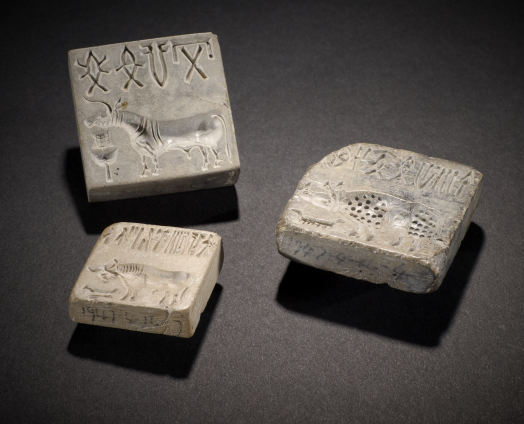
Archaeology in the Indus Valley
Harappa and Mohenjo-daro are the two most important ancient cities to have been discovered by archaeologists in the Indus Valley in what is today Pakistan and northeast India. Excavations have shown Harappa to have once supported a population of 50,000, approximately five times larger than other towns and villages nearby. The cities showed a high level of urban planning. They had a dense network of streets within strong city walls, granaries to store food and the world’s earliest system of sanitation and water supply with wells, bathing rooms and covered drains. Houses had sleeping and cooking areas, courtyards and upper stories.
As well as the carved stone seals, archaeologists have found figurines, beads, weights and pots for cooking and storage. Materials used to make these include clay, gold, semi-precious and precious stones, copper, ivory and glass. Workers in particular crafts seem to have lived near each other in districts.
The seals
These small objects have been beautifully carved out of stone and then fired to make them more durable. Over 3,500 seals have been found so far. The most typical Indus seal is square, with a set of symbols along the top, an animal in the centre, and one or more symbols at the bottom. Animals found on the seals include rhinoceros, elephants, unicorns and bulls. On the back is a projection, probably to hold while pressing the seal into other materials such as clay. The projections also have a hole for thread, presumably so the seal can be worn or carried as a necklace.
Early writing?
The symbols at the top of the seal are generally thought to form the script of the Indus Valley language. Similar markings have been found on other objects including pots and what may have been a notice board. These indicate that people wrote the first line from right to left, the second line from left to right, and so on. Around 400 different symbols have been catalogued, but the script has still not been deciphered. The inscriptions on the seals are thought to be related to trading transactions, perhaps indicating the identity of traders, makers or factories.
What might the seals tell us about trade?
The seals were pressed into soft clay to seal the mouths of jars and, as suggested by the imprint of fabric on the back of some seal impressions, were used to create clay tags for sacks of traded goods such as grain. Indus Valley seals have been found as far afield as Mesopotamia (present-day Iraq) in the cities of Umma and Ur, in Central Asia and on the coast of the Arabian Peninsula. A large number of seals have been found at the port of Lothal in western India. Finds of Mesopotamian weights in Indus Valley cities confirm that trading took place between these two civilisations. Some experts believe that Mesopotamian written records of trade in gold, copper and jewellery may be referring to the Indus Valley. It is clear that the Indus civilisation was part of an extensive long-distance trading network.
More information
A History of the world in 100 objects
An Indus seal from A History of the world in 100 objects – you can listen to the radio programme or read the transcript.
http://www.bbc.co.uk/ahistoryoftheworld/objects/RRbS0YxzQQa88y_xkV1ADg
Ancient India website
The British Museum’s Ancient India website has a whole section on the Indus Valley.
http://www.ancientindia.co.uk/indus/home_set.html
Mohenjo Daro
A website on Mohenjo Daro with many landscape and excavation photos.
http://www.mohenjodaro.net/
Indus Valley civilisations
A vast and comprehensive website on the Indus Valley civilisations with a section about the seals.
http://www.harappa.com/har/har0.html
Writing in the Indus Valley
A British Museum website with sections on Indus Valley and on writing. After the introduction click on the topic or use the globe to search for the culture.
http://www.ancientcivilizations.co.uk/
Teaching resources for the Indus Valley.
A wealth of teaching ideas, schemes of work and teaching resources for the Indus Valley.
http://www.harappa.com/teach/index.html
More information
-
A History of the world in 100 objects
An Indus seal from A History of the world in 100 objects – you can listen to the radio programme or read the transcript.
Source: bbc.co.uk
-
Ancient India website
The British Museum’s Ancient India website has a whole section on the Indus Valley.
Source: britishmuseum.org
-
Mohenjo Daro
A website on Mohenjo Daro with many landscape and excavation photos.
Source: mohenjodaro.net
-
Indus Valley civilisations
A vast and comprehensive website on the Indus Valley civilisations with a section about the seals.
Source: harappa.com
-
Writing in the Indus Valley
A British Museum website with sections on Indus Valley and on writing. After the introduction click on the topic or use the globe to search for the culture.
Source: britishmuseum.org
-
Teaching resources for the Indus Valley.
A wealth of teaching ideas, schemes of work and teaching resources for the Indus Valley.
Source: harappa.com


